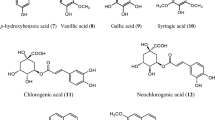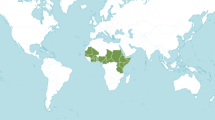Abstract
Artemisia roxburghiana Wall. ex Besser, belongs to the family Asteraceae (Compositae), is widely used in traditional medicine in Asia to treat various ailments like diabetes, rheumatism, malaria, hepatitis and helminths. In the present study, the relevant literature collected from various offline and online sources including Scopus, Web of Science and PubMed, was thoroughly reviewed for Phytochemistry, Ethnobotany and Pharmacology of A. roxburghiana. The literature survey revealed that A. roxburghiana contains a wide range of secondary metabolites like flavonoids, terpenoids, coumarins, steroids and fatty acids. The plant has been reported to be an important source of many bioactive compounds such as artemisinin, scopoletin and taraxeryl acetate. It showed anti-protozoal, anthelmintic, anti-inflammatory and antidiabetic activities in various experimental models. The present review concludes that the plant can be used to treat many human ailments; however, further research is warranted to develop it as a medicine.





Similar content being viewed by others
Abbreviations
- IL-1β:
-
Interleukin 1β
- IL-6:
-
Interleukin 6
- TNF-α:
-
Tumor necrosis factor α
- NO:
-
Nitric oxide
- COX-1:
-
Cyclooxygenase 1
- COX-2:
-
Cyclooxygenase 2
- PGE2:
-
Prostaglandin E2
- IC50 :
-
Half maximal inhibitory concentration
- AGS:
-
Adenocarcinoma gastric cell line
- WBCs:
-
White blood cells
References
Adnan M, Bibi R, Azizullah A, Andaleeb R, Mussarat S, Tariq A, Ullah R, AbdElsalam NM, Khan AL, Begum S (2015) Ethnomedicinal plants used against common digestive problems. Afr J Tradit Complement Altern Med 12:99–117
Alakurtti S, Makela T, Koskimies S, Yli-Kauhaluoma J (2006) Pharmacological properties of the ubiquitous natural product betulin. Eur J Pharm Sci 29:1–13
Ashraf M, Hayat MQ, Jabeen S, Shaheen N, Khan MA, Yasmin G (2010a) Artemisia L. species recognized by the local community of northern areas of Pakistan as folk therapeutic plants. J Med Plants Res 4:112–119
Ashraf M, Hayat MQ, Mumtaz AS (2010b) A study on elemental contents of medicinally important species of Artemisia L. (Asteraceae) found in Pakistan. J Med Plants Res 4:2256–2263
Badoni R, Semwal DK, Rawat U (2009) Altitudinal variation in the volatile constituents of Artemisia nilagirica. Int J Essent Oil Ther 3:66–68
Badoni R, Semwal DK, Rawat U (2010) Composition variation in essential oils of Artemisia nilagirica and Artemisia capillaris, growing in India. J Appl Nat Sci 2:30–33
Baker JR (1995) The subspecific taxonomy of Trypanosoma brucei. Parasite 2:3–12
Banerjee S, Haider F, Bagchi GD, Samad A (2010) Regeneration of phytoplasma-free Artemisia roxburghiana Besser var. purpurascens (Jacq.) Hook. plants using apical meristem culture. Plant Cell Tissue Organ Cult 103:189–196
Berlanga-Acosta J, López-Saura P, Guillen-Pérez I, Guillen-Nieto G, Acevedo-Castro B, Herrera-Martínez L (2013) Type 2 Diabetes Mellitus (T2DM): biological overview from pathways to organelles and its translation toward a torpid wound healing process. J Diabetes Metab 4:285
Bhat JA, Kumar M, Bussmann RW (2013) Ecological status and traditional knowledge of medicinal plants in Kedarnath Wildlife Sanctuary of Garhwal Himalaya, India. J Ethnobiol Ethnomed 9:1
Bhattarai A, Ali AS, Kachur SP, Mårtensson A, Abbas AK, Khatib R, Al-Mafazy AW, Ramsan M, Rotllant G, Gerstenmaier JF, Molteni F, Abdulla S, Montgomery SM, Kaneko A, Björkman A (2007) Impact of artemisinin-based combination therapy and insecticide-treated nets on malaria burden in Zanzibar. PLoS Med 4:e309
Bian Z, Guo Y, Ha B, Zen K, Liu Y (2012) Regulation of the inflammatory response: enhancing neutrophil infiltration under chronic inflammatory conditions. J Immunol 188:844–853
Bicchi C, Rubiolo P, Marschall H, Weyerstahl P, Laurent R (1998) Constituents of Artemisia roxburghi—ana Besser essential oil. Flavour Fragr J 13:40–46
Bicchi C, Binello A, D’Amato A, Rubiolo P (1999) Reliability of Van den Dool retention indices in the analysis of essential oils. J Chromatogr Sci 37:288–294
Cefalu WT (2007) Pharmacotherapy for the treatment of patients with type 2 diabetes mellitus: rationale and specific agents. Clin Pharmacol Ther 81:636–649
Chitale VS, Behera MD, Roy PS (2014) Future of endemic flora of biodiversity hotspots in India. PLoS ONE 9:e115264
Cumming JN, Ploypradith P, Posner GH (1997) Antimalarial activity of artemisinin (qinghaosu) and related trioxanes: mechanism(s) of action. Adv Pharmacol 37:253–297
Das SS, Dey M, Ghosh AK (2011) Determination of anthelmintic activity of the leaf and bark extract of Tamarindus indica Linn. Indian J Pharm Sci 73:104–107
Ding Z, Dai Y, Hao H, Pan R, Yao X, Wang Z (2008) Anti-inflammatory effects of scopoletin and underlying mechanisms. Pharm Biol 46:854–860
Dua VK, Verma G, Agarwal DD, Kaiser M, Brun R (2011) Antiprotozoal activities of traditional medicinal plants from the Garhwal region of North West Himalaya, India. J Ethnopharmacol 136:123–128
Ekor M (2013) The growing use of herbal medicines: issues relating to adverse reactions and challenges in monitoring safety. Front Pharmacol 4:177
Giang PM, Nhan TTT, Son PT, Matsunami K, Otsuka H (2013) A new guaianolide from Artemisia roxburghiana. Nat Prod Res 27:1856–1858
Haider F, Kumar N, Banerjee S, Naqvi AA, Bagchi GD (2009) Effect of altitude on the essential oil constituents of Artemisia roxburghiana besser var. Purpurascens (jacq.) Hook. J Essent Oil Res 21:303–304
Hayat MQ, Khan MA, Ashraf M, Jabeen S (2009) Ethnobotany of the genus Artemisia L. (Asteraceae) in Pakistan. Ethnobot Res Appl 7:147–162
Hussain Z, Waheed A, Qureshi RA, Burdi DK, Verspohl EJ, Khan N, Hasan M (2004) The effect of medicinal plants of Islamabad and Murree region of Pakistan on insulin secretion from INS-1 cells. Phytother Res 18:73–77
Joshi RK, Satyal P, Setzer WN (2016) Himalayan aromatic medicinal plants: a review of their ethnopharmacology, volatile phytochemistry, and biological activities. Medicines 3:6
Khan S, Afshan K, Mirza B, Miller JE, Manan A, Irum S, Rizvi SS, Qayyum M (2015) Anthelmintic properties of extracts from Artemisia plants against Nematodes. Trop Biomed 32:257–268
Klayman DL (1985) Qinghaosu (artemisinin): an antimalarial drug from China. Science 228:1049–1055
Li Y, Shi YP, Hu YH (1994) Chemical-constituents of Artemisia roxburghiana Bess. Indian J Chem B 33:302–304
Mannan A, Ahmed I, Arshad W, Asim MF, Qureshi RA, Hussain I, Mirza B (2010) Survey of artemisinin production by diverse Artemisia species in northern Pakistan. Malar J 9:310
Markiewski MM, Lambris JD (2007) The role of complement in inflammatory diseases from behind the scenes into the spotlight. Am J Pathol 171:715–727
Mathela CS, Kharkwal H, Shah GC (1994) Essential oil composition of some Himalayan Artemisia species. J Essent Oil Res 6:345–348
Mir RA, Wani AH, Pala SA (2012) Evaluation of in vitro inhibitory effect of Artemisia species on spore germination of powdery mildew fungus. Biopestic Int 8:168–171
Nehra S (2014) Herbal folk medicine. Pointer publishers, Jaipur
Pandey V, Verma RS, Chauhan A, Tiwari R (2015) Compositional characteristics of the volatile oils of three Artemisia spp. from western Himalaya. J Essent Oil Res 27:107–114
Phan MG, Tran TTN, Phan TS, Otsuka H, Matsunami K (2012) Two new sesquiterpene lactones and other chemical constituents of Artemisia roxburghiana. Biochem Syst Ecol 45:115–119
Rahman U, Ali S, Ubaidullah Khan I, Khan MA, Arif S, Wazir SR (2016a) Anti-inflammatory activity of taraxerol acetate. J Med Sci 24:216–219
Rahman U, Durrani S, Ubaidullah Ali S, Rahman S (2016b) Anti-pyretic activity of taraxerol acetate. Khyber J Med Sci 9:165–167
Rehman U, Shah J, Khan MA, Shah MR, Ishtiaq Khan I (2013) Molecular docking of taraxerol acetate as a new COX inhibitor. Bangladesh J Pharmacol 8:194–197
Semwal RB, Semwal DK, Mishra SP, Semwal R (2015) Chemical Composition and Antibacterial Potential of Essential Oils from Artemisia capillaris, Artemisia nilagirica, Citrus limon, Cymbopogon flexuosus, Hedychium spicatum and Ocimum tenuiflorum. Nat Prod J 5:199–205
Shah MR, Shamim A, White LS, Bertino MF, Mesaik MA, Soomro S (2014) The anti-inflammatory properties of Au-scopoletin nanoconjugates. New J Chem 38:5566–5572
Shah MR, Ishtiaq Hizbullah SM, Habtemariam S, Zarrelli A, Muhammad A, Collina S, Khan I (2016) Protein tyrosine phosphatase 1B inhibitors isolated from Artemisia roxburghiana. J Enzyme Inhib Med Chem 31:563–567
Shahwar D, Raza MA, Ahmad VU (2013) Trypsin inhibitory activity of artemisinin and its biotransformed product. J Chem Soc Pak 35:135–138
Singh DK, Hajra PK (1996) Floristic diversity. In: Gujral GS, Sharma V (eds) Changing perspective of biodiversity status in the Himalaya. British Council Division, British High Commission Publication, Wildlife Youth Services, New Delhi, pp 23–38
Stuart K, Brun R, Croft S, Fairlamb A, Gurtler RE, McKerrow J, Reed S, Tarleton R (2008) Kinetoplastids: related protozoan pathogens, different diseases. J Clin Invest 118:1301–1310
Tan B, Shi HL, Ji G, Xie JQ (2011) Effects of taraxerol and taraxerol acetate on cell cycle and apoptosis of human gastric epithelial cell line AGS. Zhong Xi Yi Jie He Xue Bao 9:638–642
Tang JJ, Li JG, Qi W, Qiu WW, Li PS, Li BL, Song BL (2011) Inhibition of SREBP by a small molecule, betulin, improves hyperlipidemia and insulin resistance and reduces atherosclerotic plaques. Cell Metab 13:44–56
The Plant List (2013) Version 1.1. Published on the Internet, http://www.theplantlist.org/. Accessed 1 Jan 2013
Tu Y (2011) The discovery of artemisinin (qinghaosu) and gifts from Chinese medicine. Nat Med 17:1217–1220
Wani AL, Ara A, Usmani JA (2015) Lead toxicity: a review. Interdiscip Toxicol 8:55–64
WHO Fact sheet (2017) Leishmaniasis. World Health Organization. Updated April 2017. http://www.who.int/mediacentre/factsheets/fs375/en. Accessed 23 Mar 2018
WHO World malaria report (2017) 29 November. Geneva: World Health Organization. http://www.who.int/malaria/publications/world-malaria-report-2017/en. Accessed 27 Mar 2018
Winzeler EA, Manary MJ (2014) Drug resistance genomics of the antimalarial drug artemisinin. Genome Biol 15:544
Wright CW (2003) Artemisia: medicinal and aromatic plants—industrial profiles. CRC Press, New York
Zhang L (2011) Flora of China, vol. 20–21, pp. 697, 701. http://www.efloras.org/florataxon.aspx?flora_id=2&taxon_id=200023316. Accessed 13 Apr 2018
Acknowledgements
This work was financially supported by National Medicinal Plants Board, Ministry of AYUSH, Govt. of India (Grant No. Z.18017/187/CSS/R&D/UK-01/2017-18-NMPB-IV A).
Author information
Authors and Affiliations
Contributions
Ankit Kumar, Sonali Aswal, and Ashutosh Chauhan contributed in the searching literature and writing this manuscript. Ruchi Badoni Semwal provided an effective analysis of the document. Deepak Kumar Semwal revised and proofread the paper.
Corresponding author
Rights and permissions
About this article
Cite this article
Kumar, A., Aswal, S., Semwal, R.B. et al. Insights on the pharmacological, phytochemical and ethnobotanical aspects of Artemisia roxburghiana: a rather less explored but therapeutically important species of lower Himalayas. Phytochem Rev 18, 199–214 (2019). https://doi.org/10.1007/s11101-018-9589-6
Received:
Accepted:
Published:
Issue Date:
DOI: https://doi.org/10.1007/s11101-018-9589-6




